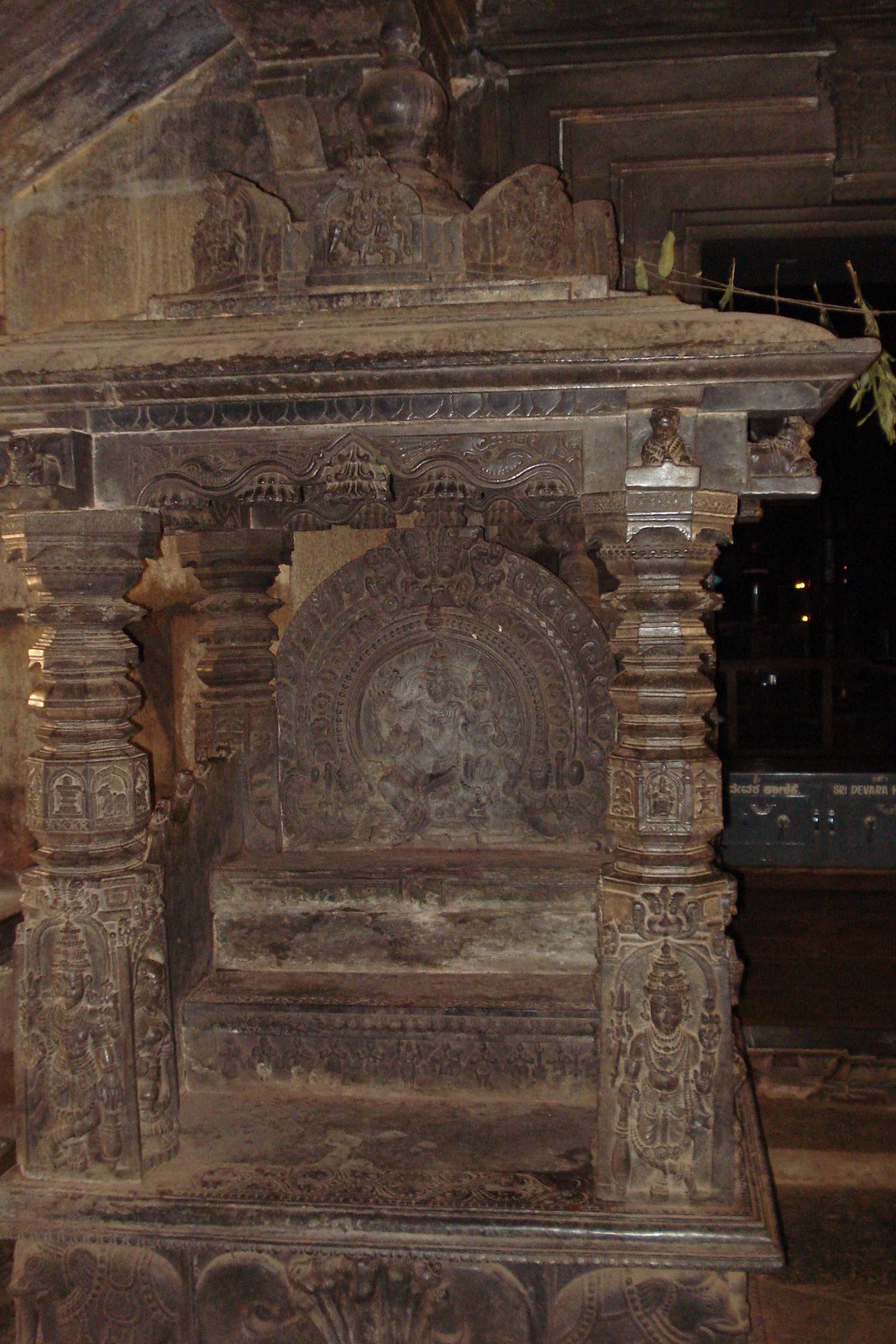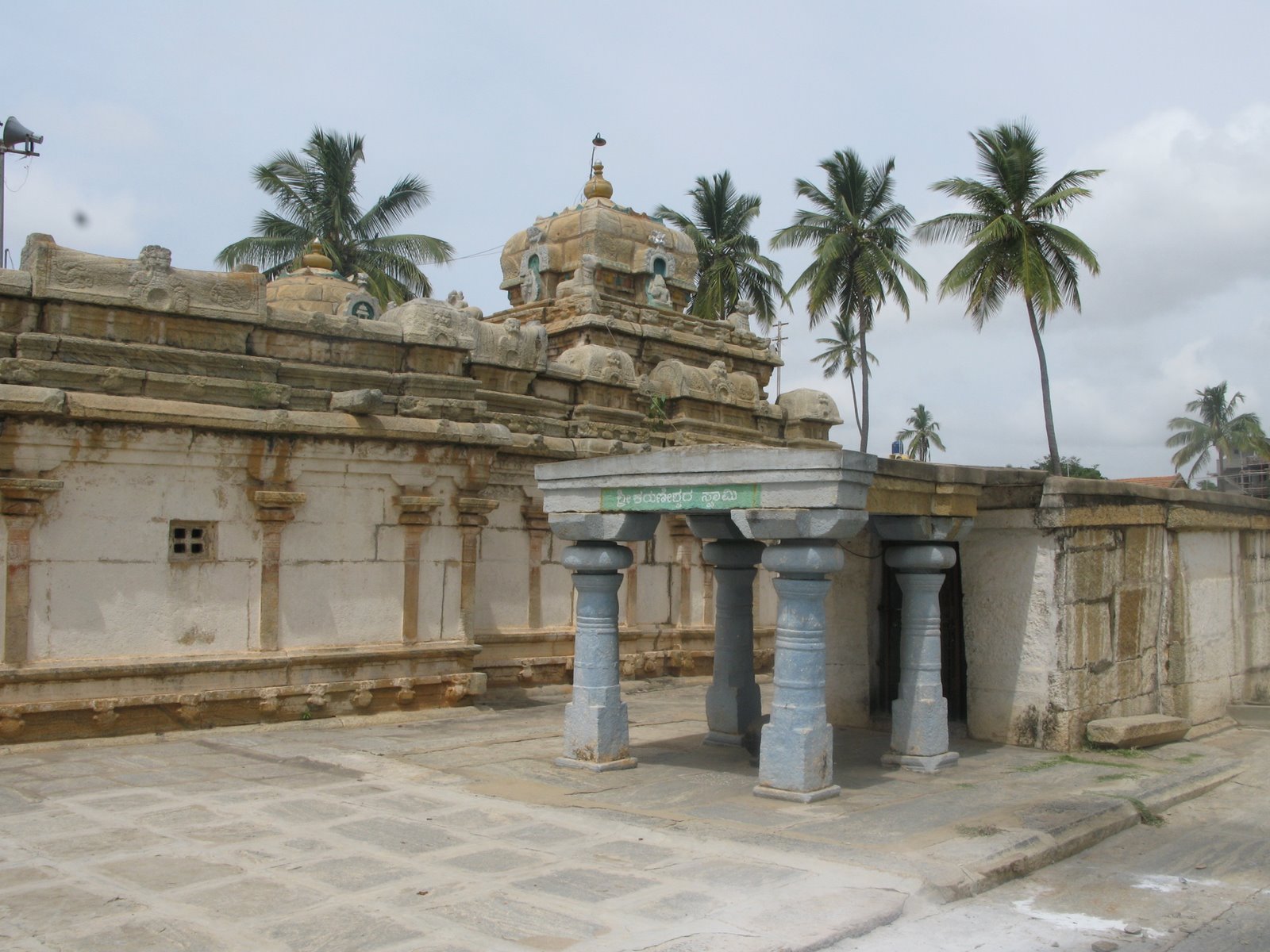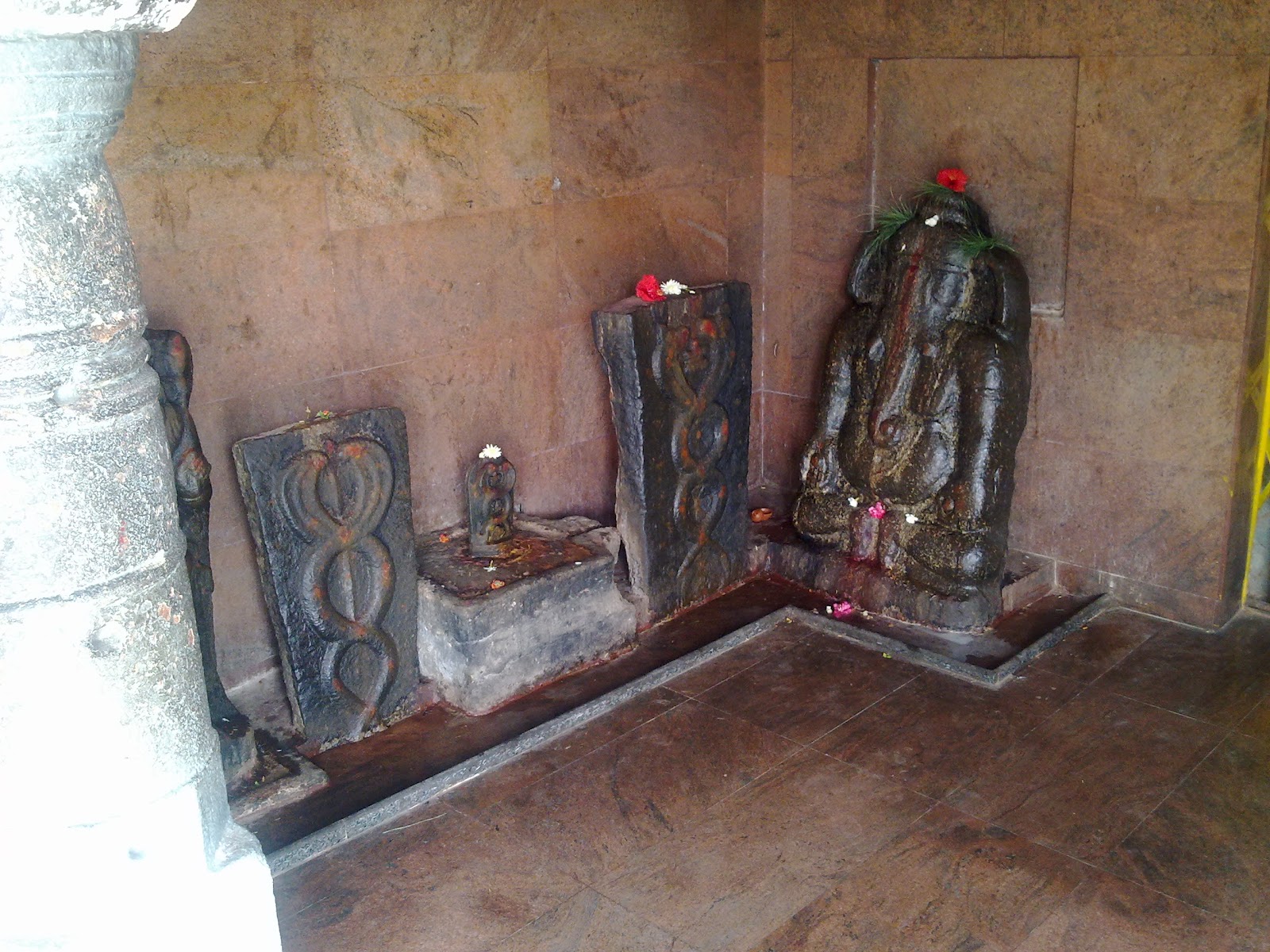
Madukeshwara temple is the most important monument of the place. Originally built by the Kadambas, it has undergone many additions and renovations, from the Chalukyas to rulers of Sonda over a period of a thousand years. ‘Madhu’ means ‘honey,’ and since the Shiva Linga is of the colour of honey, the temple is named Madhukeshwara Temple.
The temple is naturally a synthesis of several schools of architecture. With a blend of different styles, Madhukeshwara Temple provides a real treat to the admirers of architecture. The innermost sanctum sanctorum is built in a very plain style with minimal carving on the door and the lintel. The Sankalpa Mantapa, in front, reveals the influence of the Chalukya style. There is a seven-foot huge Nandi idol made of a single stone. The dancing hall was added during the Hoysala period and has exquisite carving on the pillars and the ceiling. This is the spot where the legendary Natyarani Shantala challenged the famed musician Allama Prabhu. These diverse forms in different parts of the temple amply prove that the temple has taken several centuries and contributions from many dynasties to reach its present shape. Though presently a shivalinga of ancient times is there, it is believed that original shrine was that of Vishnu. The statues of Keshava (Vishnu) and Kartikeya are also there, which are attributed to Kadamba times.
There are many smaller idols of different deities, added from time to time in the renovated temple. A unique 'Ardha Ganapathi' which literally portrays vertically-half Lord Ganesha, symbolises the bachelorhood of Ekadanta standing without the Ardhangi.The famous five-hooded Naga sculpture with the Prakrit inscription of 2nd century AD was installed by princess Sivaskanda Nagashri when she got constructed a Vihara and tank as per the inscription in second century AD. In the compound of Madhukeshwara temple, there are two monuments. The mantapa and a stone cot are beautifully carved monolithic structures, which are contributions of Sonda rulers. There are twenty temples and monuments round about Banavasi. These are mainly Shaiva Vaishnava, Shakti (Parvati and her local image, mari).
Madhukeshwara Temple, constructed during the 9th century by the Kadamba Dynasty, is famous for its architectural designs and carvings. The temple has several monolithic stone works such as a stone couch and triloka mantapa depicting heaven, earth and the nether. The idols of Lord Shiva and Lord Vishnu can be seen in the temple.

Banavasi is a small town near Sirsi (around 24km from Sirsi). It was the capital city during Kadamba’s rule. It has a rich history dating back to more than two thousand years. The main attraction in this city is the Madhukeshwara Temple built over many centuries by various dynasties including Kadamba, Hoysala and Chalukya. It is also believed that the temple is also built by the famous sculptor Amarashilpi Jakanachari.

Though the place is not a developed tourist place, we could still get some information from the priest over there (unfortunately lost the recording that I had done, but still remember some facts). The word Madhu means honey and since the Shiv Linga is in the color of honey the temple is called as Madhukeshwara temple.
Nestled deep in the forests of Western Ghats, this temple town is covered by Varada river on three sides. Its fertile soil grows rice, sugarcane, arecanut, spices and pineapple. Banavasi literally means the “inhabitant of the forest”. It is claimed that this is oldest city next only to Varanasi.


The Garbha gudi (where the lord resides in the temple) is done in a very plain style with very little carvings on pillars and doors. The Triloka mantapa where the lord is offered puja reveals Chalukya influence. The Triloka mantapa is believed to be carved out of a single stone.

There is also a dancing hall in the front which was done during the Hoysala period. It has some exquisite carvings on pillars and on the ceiling which basically form the dancing hall. It hall has four pillars which is carved in such a way that it has mirror like finish. It is believed that this shiny surface acted as a miror so that many people could watch the dance performance which used to take place.
The Bell which hangs just outside the Garba Gudi has an unique feature, which when ringed the vibration lasts for a minute or more and one can hear as if somebody is chanting the word “OM”.
These diverse forms in different parts of the temple amply prove that the temple has taken several centuries and contributions from many dynasties to reach its present shape.
There is also a stone cot (kallu Mancha) dedicated to the lord. It is also carved out of a single stone. The Triloka mantapa and Stone cot are the contributions of Sonda rulers.



Like in any other Lord Shiva temple there is a Nandi idol carved out of a single stone which stands in front of the lord 7 feet tall. There is an interesting fact about this Nandi idol. It is not facing the lord straight but slightly deviated towards the right since it is guarding two of them, with one eye watching the lord and with other watching Devi Parvathi. One can clearly view the right eye of Nandi from the Goddess Parvathi temple even through numerous pillars. Such is the genius of the sculptor.

Another significant temple in the premises is that of Shantha narasimha portrayed with two hands (rather than the usual four hands). The unique feature of this idol is its eye opening which changes with the light intensity (its portraits wide open eyes in the dark and when bright it eye lids looks as if closing down)
There are many smaller idols of different deities, added from time to time in the renovated temple. A unique ‘Ardha Ganapathi’ which literally portrays vertically-half Lord Ganesha can be seen in the temple premises. It is beleived that the other half of it is located in Varanasi.


It also has Goddess Parvathi Devi, Lord Vishnu, Parashurama, Dhundiraj ganapathi idols, Astadikpalakaru statue etc. The famous five hooded Naga sculpture with the prakrit inscription of 2nd century was installed by princess Sivaskanda Nagashri when she got constructed a Vihara and tank as per the inscription in second century.



The best time to visit would be during the Rathotsava in March, Mahashivarathri and during the two day Kadambotsava cultural festival in December every year.
The temple is naturally a synthesis of several schools of architecture. With a blend of different styles, Madhukeshwara Temple provides a real treat to the admirers of architecture. The innermost sanctum sanctorum is built in a very plain style with minimal carving on the door and the lintel. The Sankalpa Mantapa, in front, reveals the influence of the Chalukya style. There is a seven-foot huge Nandi idol made of a single stone. The dancing hall was added during the Hoysala period and has exquisite carving on the pillars and the ceiling. This is the spot where the legendary Natyarani Shantala challenged the famed musician Allama Prabhu. These diverse forms in different parts of the temple amply prove that the temple has taken several centuries and contributions from many dynasties to reach its present shape. Though presently a shivalinga of ancient times is there, it is believed that original shrine was that of Vishnu. The statues of Keshava (Vishnu) and Kartikeya are also there, which are attributed to Kadamba times.
There are many smaller idols of different deities, added from time to time in the renovated temple. A unique 'Ardha Ganapathi' which literally portrays vertically-half Lord Ganesha, symbolises the bachelorhood of Ekadanta standing without the Ardhangi.The famous five-hooded Naga sculpture with the Prakrit inscription of 2nd century AD was installed by princess Sivaskanda Nagashri when she got constructed a Vihara and tank as per the inscription in second century AD. In the compound of Madhukeshwara temple, there are two monuments. The mantapa and a stone cot are beautifully carved monolithic structures, which are contributions of Sonda rulers. There are twenty temples and monuments round about Banavasi. These are mainly Shaiva Vaishnava, Shakti (Parvati and her local image, mari).
Madhukeshwara Temple, constructed during the 9th century by the Kadamba Dynasty, is famous for its architectural designs and carvings. The temple has several monolithic stone works such as a stone couch and triloka mantapa depicting heaven, earth and the nether. The idols of Lord Shiva and Lord Vishnu can be seen in the temple.
Banavasi is a small town near Sirsi (around 24km from Sirsi). It was the capital city during Kadamba’s rule. It has a rich history dating back to more than two thousand years. The main attraction in this city is the Madhukeshwara Temple built over many centuries by various dynasties including Kadamba, Hoysala and Chalukya. It is also believed that the temple is also built by the famous sculptor Amarashilpi Jakanachari.
Though the place is not a developed tourist place, we could still get some information from the priest over there (unfortunately lost the recording that I had done, but still remember some facts). The word Madhu means honey and since the Shiv Linga is in the color of honey the temple is called as Madhukeshwara temple.
Nestled deep in the forests of Western Ghats, this temple town is covered by Varada river on three sides. Its fertile soil grows rice, sugarcane, arecanut, spices and pineapple. Banavasi literally means the “inhabitant of the forest”. It is claimed that this is oldest city next only to Varanasi.


The Garbha gudi (where the lord resides in the temple) is done in a very plain style with very little carvings on pillars and doors. The Triloka mantapa where the lord is offered puja reveals Chalukya influence. The Triloka mantapa is believed to be carved out of a single stone.
There is also a dancing hall in the front which was done during the Hoysala period. It has some exquisite carvings on pillars and on the ceiling which basically form the dancing hall. It hall has four pillars which is carved in such a way that it has mirror like finish. It is believed that this shiny surface acted as a miror so that many people could watch the dance performance which used to take place.
The Bell which hangs just outside the Garba Gudi has an unique feature, which when ringed the vibration lasts for a minute or more and one can hear as if somebody is chanting the word “OM”.
These diverse forms in different parts of the temple amply prove that the temple has taken several centuries and contributions from many dynasties to reach its present shape.
There is also a stone cot (kallu Mancha) dedicated to the lord. It is also carved out of a single stone. The Triloka mantapa and Stone cot are the contributions of Sonda rulers.


Like in any other Lord Shiva temple there is a Nandi idol carved out of a single stone which stands in front of the lord 7 feet tall. There is an interesting fact about this Nandi idol. It is not facing the lord straight but slightly deviated towards the right since it is guarding two of them, with one eye watching the lord and with other watching Devi Parvathi. One can clearly view the right eye of Nandi from the Goddess Parvathi temple even through numerous pillars. Such is the genius of the sculptor.

Another significant temple in the premises is that of Shantha narasimha portrayed with two hands (rather than the usual four hands). The unique feature of this idol is its eye opening which changes with the light intensity (its portraits wide open eyes in the dark and when bright it eye lids looks as if closing down)
There are many smaller idols of different deities, added from time to time in the renovated temple. A unique ‘Ardha Ganapathi’ which literally portrays vertically-half Lord Ganesha can be seen in the temple premises. It is beleived that the other half of it is located in Varanasi.


It also has Goddess Parvathi Devi, Lord Vishnu, Parashurama, Dhundiraj ganapathi idols, Astadikpalakaru statue etc. The famous five hooded Naga sculpture with the prakrit inscription of 2nd century was installed by princess Sivaskanda Nagashri when she got constructed a Vihara and tank as per the inscription in second century.



How to Get to Madhukeshwara
The nearest airport to Banavasi is Hubli which is 100 km away. Nearest Railway Station is at Haveri, 50 km away. The easiest way to reach Banavasi is to get a bus to Sirsi, a major bus Terminus 23 km away. From Sirsi, regular bus service is available to Banavasi.The best time to visit would be during the Rathotsava in March, Mahashivarathri and during the two day Kadambotsava cultural festival in December every year.





















